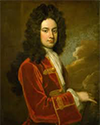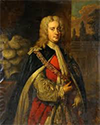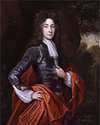King George I of Great Britain and Ireland
Part 2: On the Throne George also didn't help his case so much by arriving in England on Sept. 18, 1714, accompanied not by a wife (because he had not remarried) but by two other women, and by not being able to speak English. Nonetheless, he was crowned King of Great Britain and Ireland on October 20 at Westminster Abbey. Elsewhere, rioting against his ascension took place in dozens of towns. 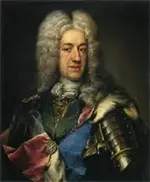
James Stuart, later known as the "Old Pretender," still had many powerful allies in England and Scotland. In 1715, a number of these people, led by the Scottish nobleman Lord Mar, declared their case to have the realm ruled by King James III and resorted to violence to press their case. The Duke of Argyll led the king's defense. A couple of English victories later, the first Jacobite uprising was in trouble. James arrived from exile in France but didn't make much of a difference in pursuing his fortunes and returned to France the following year. English forces had prevailed at Sheriffmuir, effectively ending the rebellion. (A small Scottish incursion into northern England amounted to little and ended in defeat at Preston.) Meanwhile, George's government had arrested the leaders of the rebellion and sentenced them to death, after being convicted at trial of treason. The 1717 Indemnity Act issued pardons for most of the rebellion leaders; an exception was Clan Gregor, one of whom was Rob Roy MacGregor. 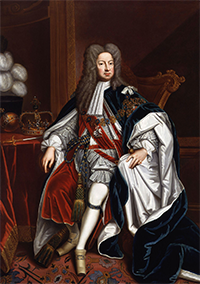
Also in 1717, George, who favored dealing in foreign policy much more than in domestic policy, put together the Triple Alliance, along with the Dutch Republic and France, in order to counter Spain. The addition of the Holy Roman Empire the following year made it the Quadruple Alliance, and that group lent its name to yet another war against France. The 1713 Treaty of Utrecht had declared that Philip, the grandson of France's Louis XIV, was to be the king of Spain but not France and that Spain would not contest ownership of territory lost during the War of the Spanish Succession. When Louis XIV died in 1715, Philip sought to regain that territory. Fighting in the War of the Quadruple Alliance took place not only in Europe but also in North America. The war initially went the way of Spain, but the addition of Austrian forces in 1718 turned the tide the other way. The Treaty of Hague in 1720 ended the fighting, with Spain relinquishing all of the territory that it had seized during the war. The Jacobites hadn't given up, and they found a new ally in Spain. A 1719 invasion, occurring during the War of the Quadruple Alliance, fell afoul of the weather, which prevented most ships from landing. The ships that did land sent Spanish soldiers to fight alongside Scottish soldiers, but England still prevailed, at the Battle of Glen Shiel. 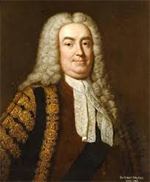
In the same year that George became king, elections for Parliament took place. The result was a large majority of members of the Whig Party, led by Robert Walpole. The very next year, the Whig-dominated Parliament passed the Septennial Act 1715, which stated that Parliament could be in power for up to seven years. (The previous maximum term was three years, as stipulated in the Triennial Act passed by the Long Parliament during the reign of Charles I.) The king began his reign by regularly attended meetings of his cabinet. The king didn't speak English, but his son, George, did. The Prince of Wales translated for the king. (The king did speak French, German, Latin, and a bit of Dutch and Italian.) Directing foreign policy along with the king during the first part of his reign was Lord Townshend, who served as Secretary of State for the Northern Department. King George dismissed Townshend from his
Another of the king's top ministers was James Stanhope, who began in George's service as Secretary of State for the Southern Department and later served as First Lord of the Treasury, Chancellor of the Exchequer, and the Secretary of State for the Northern Department, succeeding to the last of those positions when the king dismissed Townshend. Also at one point serving as First Lord of the Treasury was an ally of Stanhope, Charles Spencer, the Earl of Sunderland. It was a political schism that split George's leadership team; when the king dismissed Townshend, Walpole resigned, and this left Stanhope and Sunderland in power, effectively running the foreign affairs and domestic affairs, respectively. Walpole was still in Parliament, however, and led the opposition to one of Sunderland's signature bills, the Peerage Bill, which sought to limit the size of the House of Lords. King George eventually sought to keep the peace by returning Townshend and Walpole to the ministerial circle. One of the most damaging events in British economic history occurred in 1720. The South Sea Bubble resulted in the loss of enormous sums of money by a great many nobles in Britain and in the loss of prestige of the king and his chief ministers. Walpole of all the chief ministers emerged relatively unscathed from the scandal and, in 1721, became the realm's first Prime Minister. After the South Sea scandal, the king attended very few cabinet meetings, leaving Walpole to run the government. George spent more and more time at his ancestral home, in Hanover. One thing that the king and Walpole did collaborate on in George's later reign was the establishment in 1725 of the Order of the Bath, an order of chivalry that was championed by John Anstis. The order exists to this day. George I's relationship with his son was rarely a good one. The younger George had begun his father's reign by attending cabinet meetings and acting as a translator between his German-only-speaking father and ministers who chose to spoke English. A rift in 1717 drove father and son apart, where they remained for the rest of the elder George's life, a brief reconciliation in 1720 engineered by Walpole being the only exception. George's former wife, Sophia Dorothea, had languished in prisoner in a German castle. She died in November 1726. King George I was in Hanover when he died. He suffered a stroke while traveling between Delden and Nordhorn. He died at the Bishop's Palace at Osnabruck on June 11, 1727. He was 67. His son succeeded him, becoming King George II. His daughter later married Frederick the Great. 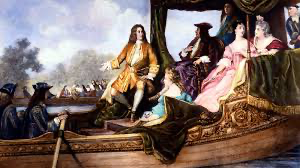
One of the most famous artists living in England during George I's reign was George Frideric Handel. The premier of his work Water Music, took place on July 17, 1717, on a barge on the River Thames, with the king in attendance. Other nonpolitical, nonmilitary highlights of Great Britain during the reign of George I:
First page > King-in-waiting > Page 1, 2 |
|
Social Studies for Kids
copyright 2002–2025
David White



